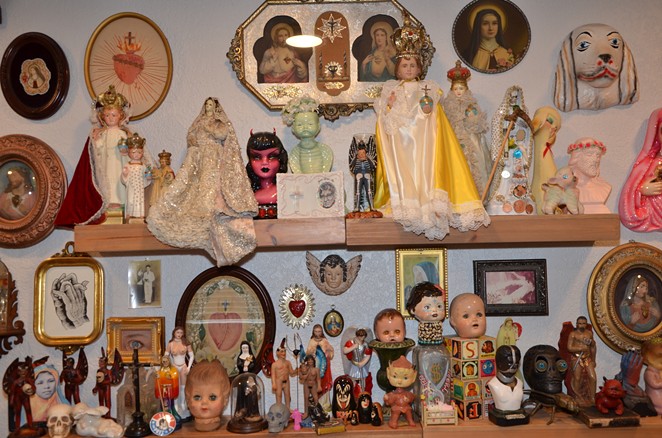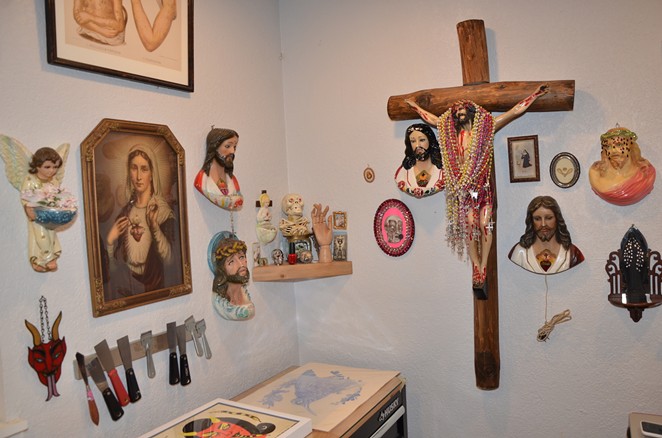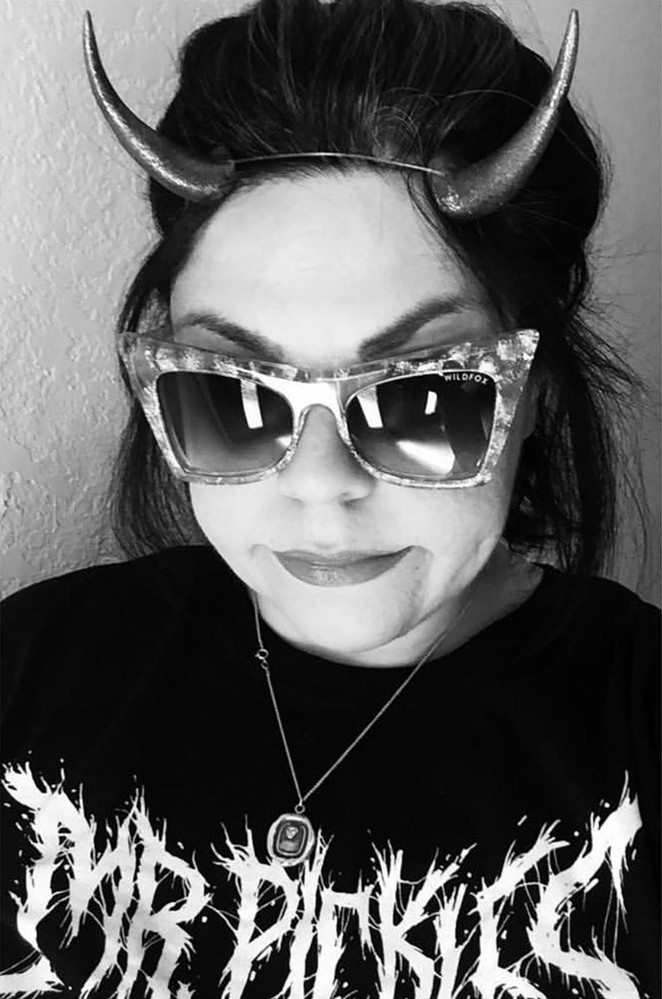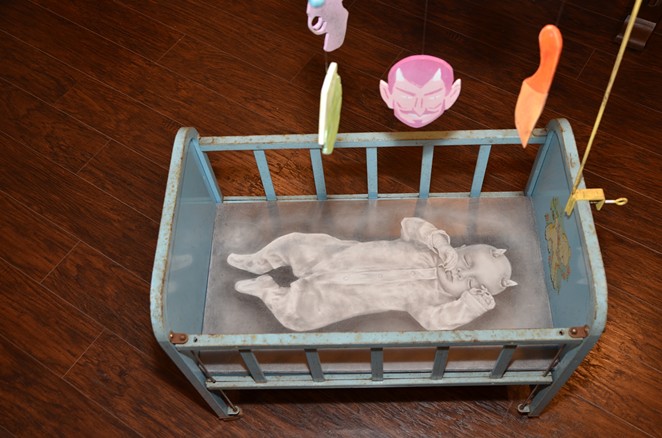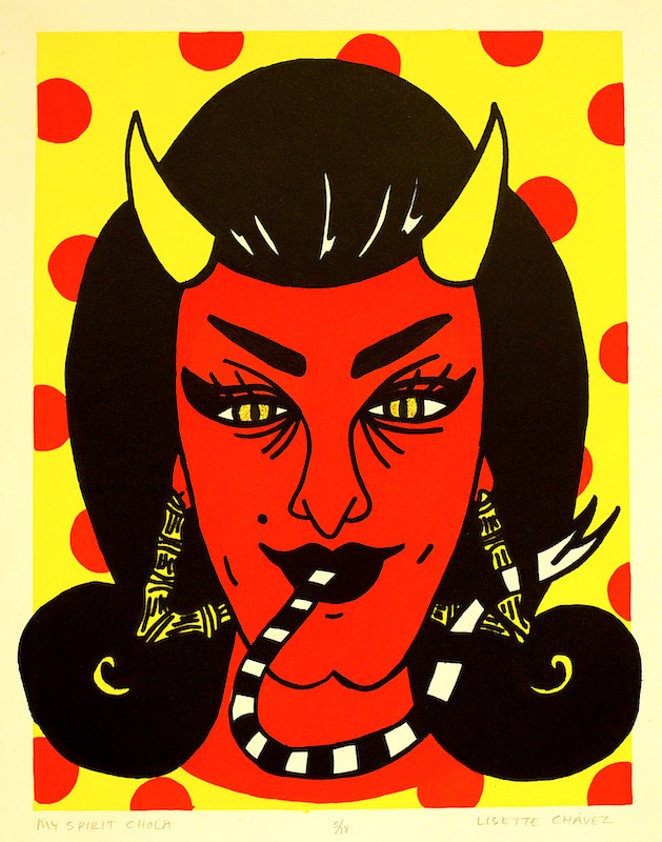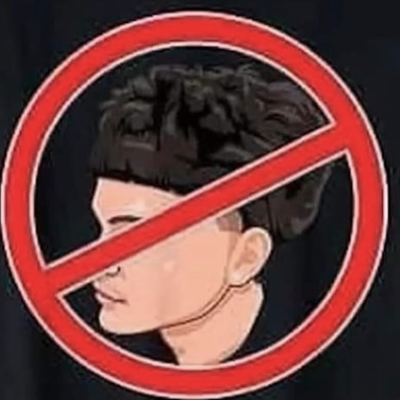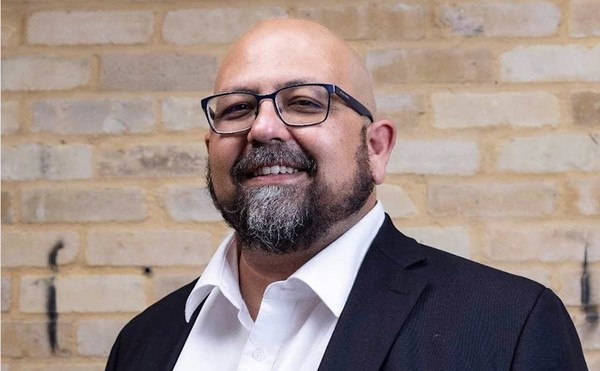Studio Visits: San Antonio Artist Lisette Chavez on Growing Up Catholic, Devil Babies and Men Who Look Like Satan
By Bryan Rindfuss on Wed, Jul 3, 2019 at 10:00 am
Stepping inside an artist’s studio is an enlightening experience that can reveal creative processes, influences, habits and eccentricities — not to mention glimpses of works in progress and plans for projects on the horizon. For reasons that go beyond the practical and the financial, many artists opt to carve out dedicated studio spaces in their own homes or set up mobile workstations. In this new column, we’ll be highlighting diverse San Antonio artists and their work through visits to their studios — whether they be traditional offsite spaces or makeshift operations in garages and guest bedrooms or on couches and kitchen tables.
Tucked into a repurposed guest bedroom in a 1960s-era home in Harmony Hills, the compact studio of visual artist Lisette Chavez creates a bizarre, provocative juxtaposition with the unassuming neighborhood that surrounds it. Upon entering, the first objects to make an impression are religious in nature — a large wooden crucifix dripping with dozens of rosaries, wall-mounted busts of Jesus Christ, saintly statues and framed depictions of sacred hearts, praying hands and the Virgin Mary. But as one’s eyes adjust to the vignettes, sinister spirits emerge. Devils of varying shapes, sizes and styles pepper the shelves alongside skulls, detached doll heads and figurines of the pre-Columbian death goddess Nuestra Señora de la Santa Muerte. Further inspection evidences bloodshot eyes of judgement, crystal tears of guilt, bedazzled interventions on holy objects, even a bit of full-frontal nudity. Part installation, part altar, the arrangement proves that Chavez is not just an artist but a collector and a tinkerer with a taste for the macabre and a wicked sense of humor to boot.
Born in Harlingen in the Rio Grande Valley, Chavez and her older brother grew up in a conservative Catholic family. Dad was a car salesman, Mom was a homemaker and caregiver, and they were “always in church.” Experienced at the hands of a devout and idiosyncratic matriarch, Catholic traditions left enduring — and at times traumatic — impressions on Chavez. At the tender age of 4, she was forced to confront death while attending her grandmother’s funeral. Too short to peer into the coffin even when perched on the kneeler, Chavez was swept up by her mother and held over the body.
“It’s a very vivid memory — of the rosary, wrinkles, bruises, a lot of the ruffles on the inside of the coffin and the crucifix,” she said.
Five years later, she was thrust into her first confession as a timid 9-year-old. After being informed that the priest only had time to listen to one more confession, her mother made her to jump the line in front of others who were patiently waiting — including an elderly woman wearing a mantilla.
“My mom just grabbed my arm and picked me up … and shoved me,” Chavez recalled.
In what might be attributed to an early act of rebellion, Chavez lied to the priest, offering him a watered-down version of her childhood sins. “There’s a lot of contradiction, a lot of religious hypocrisy in my family — and just in general,” she added.
Despite all this, Chavez felt a calling to become a nun at the age of 17.
“I felt like I was always in trouble for speaking my mind and my family didn’t understand me,” she explained. “I was an outcast in high school too. I thought my mother would be happy when I told her I wanted to become a nun, but she was very angry. [She] told me I was crazy, and she forbid it. The mixed signals from my home life were very confusing.”
Having always loved drawing, Chavez instead opted for a Plan B that brought her to San Antonio to study art at the University of the Incarnate Word. Upon graduation, she returned to the Valley and found there were no suitable jobs that matched her skill set, then briefly considered going back to school to study mortuary science.
“I think because of that traumatic experience of seeing my grandmother in her coffin, I was always interested in funerals and mortuary science,” she said.
With assistance from an uncle who worked at a funeral home, she met with an embalmer and observed his work on a recently deceased woman in her 70s.
“I witnessed the entire embalming, and I thought it was amazing,” Chavez said. “I thought it seemed as if she had somehow come back to life. As soon as that happened, he sort of shrugged his shoulders and said, ‘And that’s about it. It’s like taking out the trash — someone has to do it.’ I left and cried all the way home. I hated that man for saying it [and] for being so callous … I swore I wouldn’t be that way … So for fear of becoming that cold-hearted, I didn’t go down that route after all. I feel it was fate.”
Fate in this case meant diving deeper into art and earning an MA from Texas A&M in Corpus Christi and an MFA from the University of Arizona in Tucson. While in Corpus, she started taking printmaking classes and found her niche within the realm of lithography.
“I just fell in love with it right away, especially drawing on limestone,” she said. Her new medium of choice played a key role in her senior thesis exhibition “Early Mourning” — an installation based on the childhood memory of attending her grandmother’s funeral. “[It] was a huge turning point, because I hadn’t ever done installation art before. It was a chapel [with] lithographs on the outside acting as windows.” On the inside, Chavez’s intricate prints of skulls and decaying animals coalesced with religious paraphernalia, tchotchkes, and objects conjuring a Día de los Muertos altar.
Chavez’s evolution as an artist continued significantly in Tucson.
“When I went there, I had some of the tools … like installation, and I knew lithography and I could render really well. [But] they were very conceptual [and] were like, ‘So you can draw, who cares?’ And it was kind of like a slap in the face. I felt really lost for a bit.”
A pivotal studio visit with her painting professor set her on a more concentrated path of self-discovery. In preparation, Chavez was asked to present her own work alongside the work of her influences — which at the time included outlandish and morbid provocateurs such as Joe Coleman, Laurie Lipton and Aurel Schmidt.
Noticing a major disconnect, her professor asked her why her work was so sweet and innocent compared to the gritty output of her influences. “And it just kind of hit me,” Chavez said. “It’s probably because I was raised Catholic [laughs]. And I see it now, how it was just black-and-white. She said, ‘OK, so you were raised Catholic. I think you should think about that a little more.’ I was always kind of thinking about that, and then … I started realizing that I was censoring myself … because of my family and how conservative they are … I hadn’t done [certain] things because I knew somebody was going to see them. It was almost like the embarrassment of showing those ideas, of somebody knowing that you thought about those things was embarrassing to me.”
That realization sparked Chavez to dig deeper and express her authentic self in yet another thesis exhibition drawn from her Catholic upbringing. A shrine-like installation inspired by the lies she told a priest as a child, “My First Confession” took shape in intricate drawings, altered religious objects, text-based confessionals and a kneeler printed with the phrase “Sorry, Not Sorry.”
While she must have known it represented a major breakthrough in her work, Chavez decided not to invite her family to the opening and felt anxious about how the installation would be received.
“I just thought somebody was going to come up to me and slap me or something,” she said. Instead of getting slapped, she got hugged. “A lot of young women were really drawn to it because I think they could see the rebellious part of me. … I think they knew exactly where I was coming from. It was really intense. Some people would come up to me and be like, ‘Can I hug you?’ And then I had so many people tell me, ‘I lied at my first confession too!’”
Since her university days, Chavez has continued to develop work exploring personal memories, religious hypocrisy, blind faith, the occult and anger aimed at the Trump administration. Outside of an extensive exhibition history that includes galleries and museums in Texas as well as Australia, Estonia, Egypt, France and South America, she teaches drawing and printmaking in San Antonio and across the state. During our visit, we discussed recent projects as well as key themes that inform her work.
Mommy Issues Beyond being dragged to a funeral and confession at what some might say is an inappropriate age, Chavez is inescapably tied to her mother.
“My mother — it always goes back to my mother,” she said. “The relationship with my mother is really toxic but it’s also addicting. I just can’t get away from it, it’s horrible. There’s some kind of crazy dynamic there. I see myself doing a lot of the same things she does.”
Paralleling Chavez’s fascination with death and the macabre, her mother is something of a funeral fanatic. “I can’t even tell you how many funerals I’d been to by the time I was 10,” she said. “[My dad and I] would make fun of my mom. … He’d be like, ‘Oh, your mother’s a professional mourner.’ She’ll open the newspaper and go straight to the obituaries in the morning [and] be like, ‘So-and-so died, and I knew his cousin. I’m gonna go to that funeral.’ And they’re really intense, you know? Especially the ones in Latino families. Lots of praying, lots of crying. Very dramatic. And she just loves it. … I told her, ‘Mom, you’re so Goth.’ I would tell her that when I was in high school. … But now I see [that she’s] trying to be there for someone during their darkest moments. … And so now I see it as a really sweet thing.”
Devilish Dudes When Chavez was growing up, her ever-influential mother had a habit of pointing out men who resembled the Devil.
“When I was a kid, if we were at H-E-B or the mall or something, my mom would say this little prayer Ave Maria Purísima and do the sign of the cross really intensely. And I would look and she would say in Spanish, ‘That man looks like the Devil.’ She did it all the time, like everywhere.”
Not only did Chavez inherit this peculiar habit to a certain degree, she started sketching the sinister-looking men. Published in 2016, her covetable zine Men Who Look Like Satan includes quickly rendered yet entirely recognizable drawings of Clark Gable, Gene Simmons, Willem Dafoe, Carrot Top, Danny Trejo and Ron Jeremy.
“It’s gotten to the point that so many of my friends knew about it that they would send me screenshots,” she said. “I just think it’s so funny because everybody knows what I’m talking about.” Volume two is reportedly in the works, and even Mom contributed an idea that’s already in the bag: professional basketball player Anthony Davis.
Rosemary’s Baby “The devil baby and the devil woman have all been pretty persistent in my work for the past two years,” Chavez explained.
One of the more arresting objects in her studio is a full-sized crib that functions as a three-dimensional frame for a photo-realistic drawing of an infant with tiny devil horns. Partly inspired by the terrifying HBO miniseries The Night Of, Chavez’s recurring devil child is also a reflection of herself and her thoughts and fears of motherhood.
“I think [it’s] kind of like a self-portrait in a way — [a depiction] of not being perfect,” she said. “But [it’s] also this rebirthing of ideas that my mother has instilled in me. Like her wanting me to be this perfect person [that I’m] not. And [the fear that] the same thing’s gonna happen if I have a child too.”
Spirit Animal Another commanding presence in Chavez’s studio at the moment is a devilish woman she describes as her “Spirit Chola.” With red skin, yellow horns, a venomous looking forked tongue and gaudy gold earrings, the character was created for a collaborative print portfolio titled Nasty Women. A creative response to the pussy-grabbing villain in the nation’s highest office, the character is also a visual representation of Chavez’s admiration for the cholas she encountered in high school.
“I’ve always been interested in cholas,” she confessed. “In grade school, you’re afraid of them because nobody fucks with them. But they still have this perfect eyeliner, perfect makeup. It’s like a symbol of perfection. Like female beauty [but] still with that tough exterior. … I loved that feminine-masculine spin. … I was always terrified of them in school because I was a Gothy, nerdy person … When I started showing these prints, there were a lot of women who really loved them because they felt like they made them stronger. And I said, ‘You know, that’s why I’m making them — because I feel like I just want to mouth off on somebody.’ So, I think out of my frustration with the Trump administration, all the racism … I started making these cholas that don’t take shit from people.”
Stay on top of San Antonio news and views. Sign up for our Weekly Headlines Newsletter.
Tucked into a repurposed guest bedroom in a 1960s-era home in Harmony Hills, the compact studio of visual artist Lisette Chavez creates a bizarre, provocative juxtaposition with the unassuming neighborhood that surrounds it. Upon entering, the first objects to make an impression are religious in nature — a large wooden crucifix dripping with dozens of rosaries, wall-mounted busts of Jesus Christ, saintly statues and framed depictions of sacred hearts, praying hands and the Virgin Mary. But as one’s eyes adjust to the vignettes, sinister spirits emerge. Devils of varying shapes, sizes and styles pepper the shelves alongside skulls, detached doll heads and figurines of the pre-Columbian death goddess Nuestra Señora de la Santa Muerte. Further inspection evidences bloodshot eyes of judgement, crystal tears of guilt, bedazzled interventions on holy objects, even a bit of full-frontal nudity. Part installation, part altar, the arrangement proves that Chavez is not just an artist but a collector and a tinkerer with a taste for the macabre and a wicked sense of humor to boot.
Born in Harlingen in the Rio Grande Valley, Chavez and her older brother grew up in a conservative Catholic family. Dad was a car salesman, Mom was a homemaker and caregiver, and they were “always in church.” Experienced at the hands of a devout and idiosyncratic matriarch, Catholic traditions left enduring — and at times traumatic — impressions on Chavez. At the tender age of 4, she was forced to confront death while attending her grandmother’s funeral. Too short to peer into the coffin even when perched on the kneeler, Chavez was swept up by her mother and held over the body.
“It’s a very vivid memory — of the rosary, wrinkles, bruises, a lot of the ruffles on the inside of the coffin and the crucifix,” she said.
Five years later, she was thrust into her first confession as a timid 9-year-old. After being informed that the priest only had time to listen to one more confession, her mother made her to jump the line in front of others who were patiently waiting — including an elderly woman wearing a mantilla.
“My mom just grabbed my arm and picked me up … and shoved me,” Chavez recalled.
In what might be attributed to an early act of rebellion, Chavez lied to the priest, offering him a watered-down version of her childhood sins. “There’s a lot of contradiction, a lot of religious hypocrisy in my family — and just in general,” she added.
Despite all this, Chavez felt a calling to become a nun at the age of 17.
“I felt like I was always in trouble for speaking my mind and my family didn’t understand me,” she explained. “I was an outcast in high school too. I thought my mother would be happy when I told her I wanted to become a nun, but she was very angry. [She] told me I was crazy, and she forbid it. The mixed signals from my home life were very confusing.”
Having always loved drawing, Chavez instead opted for a Plan B that brought her to San Antonio to study art at the University of the Incarnate Word. Upon graduation, she returned to the Valley and found there were no suitable jobs that matched her skill set, then briefly considered going back to school to study mortuary science.
“I think because of that traumatic experience of seeing my grandmother in her coffin, I was always interested in funerals and mortuary science,” she said.
With assistance from an uncle who worked at a funeral home, she met with an embalmer and observed his work on a recently deceased woman in her 70s.
“I witnessed the entire embalming, and I thought it was amazing,” Chavez said. “I thought it seemed as if she had somehow come back to life. As soon as that happened, he sort of shrugged his shoulders and said, ‘And that’s about it. It’s like taking out the trash — someone has to do it.’ I left and cried all the way home. I hated that man for saying it [and] for being so callous … I swore I wouldn’t be that way … So for fear of becoming that cold-hearted, I didn’t go down that route after all. I feel it was fate.”
Fate in this case meant diving deeper into art and earning an MA from Texas A&M in Corpus Christi and an MFA from the University of Arizona in Tucson. While in Corpus, she started taking printmaking classes and found her niche within the realm of lithography.
“I just fell in love with it right away, especially drawing on limestone,” she said. Her new medium of choice played a key role in her senior thesis exhibition “Early Mourning” — an installation based on the childhood memory of attending her grandmother’s funeral. “[It] was a huge turning point, because I hadn’t ever done installation art before. It was a chapel [with] lithographs on the outside acting as windows.” On the inside, Chavez’s intricate prints of skulls and decaying animals coalesced with religious paraphernalia, tchotchkes, and objects conjuring a Día de los Muertos altar.
Chavez’s evolution as an artist continued significantly in Tucson.
“When I went there, I had some of the tools … like installation, and I knew lithography and I could render really well. [But] they were very conceptual [and] were like, ‘So you can draw, who cares?’ And it was kind of like a slap in the face. I felt really lost for a bit.”
A pivotal studio visit with her painting professor set her on a more concentrated path of self-discovery. In preparation, Chavez was asked to present her own work alongside the work of her influences — which at the time included outlandish and morbid provocateurs such as Joe Coleman, Laurie Lipton and Aurel Schmidt.
Noticing a major disconnect, her professor asked her why her work was so sweet and innocent compared to the gritty output of her influences. “And it just kind of hit me,” Chavez said. “It’s probably because I was raised Catholic [laughs]. And I see it now, how it was just black-and-white. She said, ‘OK, so you were raised Catholic. I think you should think about that a little more.’ I was always kind of thinking about that, and then … I started realizing that I was censoring myself … because of my family and how conservative they are … I hadn’t done [certain] things because I knew somebody was going to see them. It was almost like the embarrassment of showing those ideas, of somebody knowing that you thought about those things was embarrassing to me.”
That realization sparked Chavez to dig deeper and express her authentic self in yet another thesis exhibition drawn from her Catholic upbringing. A shrine-like installation inspired by the lies she told a priest as a child, “My First Confession” took shape in intricate drawings, altered religious objects, text-based confessionals and a kneeler printed with the phrase “Sorry, Not Sorry.”
While she must have known it represented a major breakthrough in her work, Chavez decided not to invite her family to the opening and felt anxious about how the installation would be received.
“I just thought somebody was going to come up to me and slap me or something,” she said. Instead of getting slapped, she got hugged. “A lot of young women were really drawn to it because I think they could see the rebellious part of me. … I think they knew exactly where I was coming from. It was really intense. Some people would come up to me and be like, ‘Can I hug you?’ And then I had so many people tell me, ‘I lied at my first confession too!’”
Since her university days, Chavez has continued to develop work exploring personal memories, religious hypocrisy, blind faith, the occult and anger aimed at the Trump administration. Outside of an extensive exhibition history that includes galleries and museums in Texas as well as Australia, Estonia, Egypt, France and South America, she teaches drawing and printmaking in San Antonio and across the state. During our visit, we discussed recent projects as well as key themes that inform her work.
Mommy Issues Beyond being dragged to a funeral and confession at what some might say is an inappropriate age, Chavez is inescapably tied to her mother.
“My mother — it always goes back to my mother,” she said. “The relationship with my mother is really toxic but it’s also addicting. I just can’t get away from it, it’s horrible. There’s some kind of crazy dynamic there. I see myself doing a lot of the same things she does.”
Paralleling Chavez’s fascination with death and the macabre, her mother is something of a funeral fanatic. “I can’t even tell you how many funerals I’d been to by the time I was 10,” she said. “[My dad and I] would make fun of my mom. … He’d be like, ‘Oh, your mother’s a professional mourner.’ She’ll open the newspaper and go straight to the obituaries in the morning [and] be like, ‘So-and-so died, and I knew his cousin. I’m gonna go to that funeral.’ And they’re really intense, you know? Especially the ones in Latino families. Lots of praying, lots of crying. Very dramatic. And she just loves it. … I told her, ‘Mom, you’re so Goth.’ I would tell her that when I was in high school. … But now I see [that she’s] trying to be there for someone during their darkest moments. … And so now I see it as a really sweet thing.”
Devilish Dudes When Chavez was growing up, her ever-influential mother had a habit of pointing out men who resembled the Devil.
“When I was a kid, if we were at H-E-B or the mall or something, my mom would say this little prayer Ave Maria Purísima and do the sign of the cross really intensely. And I would look and she would say in Spanish, ‘That man looks like the Devil.’ She did it all the time, like everywhere.”
Not only did Chavez inherit this peculiar habit to a certain degree, she started sketching the sinister-looking men. Published in 2016, her covetable zine Men Who Look Like Satan includes quickly rendered yet entirely recognizable drawings of Clark Gable, Gene Simmons, Willem Dafoe, Carrot Top, Danny Trejo and Ron Jeremy.
“It’s gotten to the point that so many of my friends knew about it that they would send me screenshots,” she said. “I just think it’s so funny because everybody knows what I’m talking about.” Volume two is reportedly in the works, and even Mom contributed an idea that’s already in the bag: professional basketball player Anthony Davis.
Rosemary’s Baby “The devil baby and the devil woman have all been pretty persistent in my work for the past two years,” Chavez explained.
One of the more arresting objects in her studio is a full-sized crib that functions as a three-dimensional frame for a photo-realistic drawing of an infant with tiny devil horns. Partly inspired by the terrifying HBO miniseries The Night Of, Chavez’s recurring devil child is also a reflection of herself and her thoughts and fears of motherhood.
“I think [it’s] kind of like a self-portrait in a way — [a depiction] of not being perfect,” she said. “But [it’s] also this rebirthing of ideas that my mother has instilled in me. Like her wanting me to be this perfect person [that I’m] not. And [the fear that] the same thing’s gonna happen if I have a child too.”
Spirit Animal Another commanding presence in Chavez’s studio at the moment is a devilish woman she describes as her “Spirit Chola.” With red skin, yellow horns, a venomous looking forked tongue and gaudy gold earrings, the character was created for a collaborative print portfolio titled Nasty Women. A creative response to the pussy-grabbing villain in the nation’s highest office, the character is also a visual representation of Chavez’s admiration for the cholas she encountered in high school.
“I’ve always been interested in cholas,” she confessed. “In grade school, you’re afraid of them because nobody fucks with them. But they still have this perfect eyeliner, perfect makeup. It’s like a symbol of perfection. Like female beauty [but] still with that tough exterior. … I loved that feminine-masculine spin. … I was always terrified of them in school because I was a Gothy, nerdy person … When I started showing these prints, there were a lot of women who really loved them because they felt like they made them stronger. And I said, ‘You know, that’s why I’m making them — because I feel like I just want to mouth off on somebody.’ So, I think out of my frustration with the Trump administration, all the racism … I started making these cholas that don’t take shit from people.”
Stay on top of San Antonio news and views. Sign up for our Weekly Headlines Newsletter.

KEEP SA CURRENT!
Since 1986, the SA Current has served as the free, independent voice of San Antonio, and we want to keep it that way.
Becoming an SA Current Supporter for as little as $5 a month allows us to continue offering readers access to our coverage of local news, food, nightlife, events, and culture with no paywalls.
Scroll to read more Arts Stories & Interviews articles
Newsletters
Join SA Current Newsletters
Subscribe now to get the latest news delivered right to your inbox.

